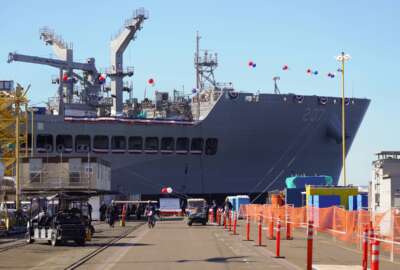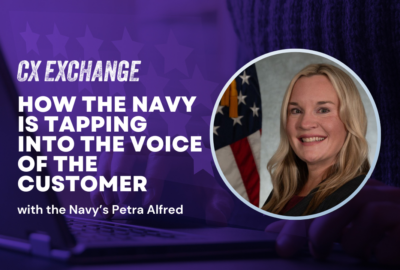Hubbard Radio Washington DC, LLC. All rights reserved. This website is not intended for users located within the European Economic Area.
How the Navy has been shaped by its operations chiefs
In its nearly 250 year history the Navy has a woman as Chief of Naval Operations. Adm. Lisa Franchetti, credited an earlier CNO for advancing women in the navy.
For the first time in its nearly 250 year history, the Navy has a woman as Chief of Naval Operations (CNO). Adm. Lisa Franchetti, in a recent Navy Times article, credited an earlier CNO (Elmo Zumwalt), for enabling women to advance in the Navy. CNOs, in fact, have exerted a lot of influence. Now the Naval History and Heritage Command has released — in hard copy — a 2015 volume detailing the activities of a century of chiefs of Naval operations. For more, the Federal Drive Host Tom Temin spoke with historian and co-author Curtis Utz.
Interview Transcript:
Curtis Utz Well, the position of Chief of Naval Operations again is legally established in 1915. But we do go back and look into the late 19th and early 20th century as to why did this position develop the greater professionalization of the Navy, the need to have better control. Because prior to this, the secretaries of the Navy are directly commanding the squadron commanders. And if you go back far enough, even individual ships. And the Navy realized that while they’d been able to succeed with this during the war with Spain, if you were going to start considering conflicts with larger naval powers, you have to be a bigger force, you have to get together, you have to be orchestrated and led by a uniformed officer that has a better understanding of what’s going on.
Tom Temin Almost like the British model where you have a politician, but you also have a professional that are close in rank, even though the politician may outrank, but really directing ships and saying, left rudder, right rudder fuel here. You need somebody that knows the ocean.
Curtis Utz Right. Well, one of the great controversies in creating this office was that secretaries of the Navy did not want to cede civilian control, which is required by the Constitution and by law for them to have. And the naval officers who were involved with this early on, they also understood that, but they were just very concerned that they didn’t have, necessarily, you would get a secretary with a good understanding of the professional and technical requirements of the early 20th century Navy.
Tom Temin Yes, there was a big shift to more mechanization. Aircraft were beginning to learn how to land on shift. It was getting complicated.
Curtis Utz Oh, yes. Very, very highly complicated. And when you look at some of the things that are in the early office of Chief of Naval Operations, they actually have the organization that oversees naval communications. You know, the development of radio, more advanced technology. Aviation is also under the organization, but they also have the people who oversee engineering and gunnery competitions, which doesn’t sound like much, but this is really advanced training. We are trying to encourage people to get better with these very sophisticated systems, because in the case of gunnery, you’re starting developed by 1910, 1912 period, where you’re throwing shells 12 or 15 miles and a pretty good physics problem to figure out if it’s going to be able to hit something. It is roughly two lengths of a football field.
Tom Temin Why did the Navy not call it the chief of staff like the other armed services?
Curtis Utz One of the things that several of the secretaries of the Navy had been worried about, and the term that a couple of them used was they were afraid of the Prussianization of the Navy because, the Prussian General Staff was very well known, and the Navy wanted to make it clear that this is more about operations. Because beyond this staff within the CNO’s office, there was the shore establishment that reported to the Secretary of the Navy, Bureau of Navigation, Bureau of Ordnance, Bureau of Construction and Repair, Bureau of Supplies and Accounts, Bureau of Medicine and Surgery, who provided a lot of the support. This organization was primarily focused on how do we go and operate.
Tom Temin Interesting. And now we have the Chief of Research in the Navy. That’s one of the ones that would be not reporting then, in this day, to the CNO.
Curtis Utz Well, at that time, I mean, [Naval Research Laboratory (NRL)] hasn’t even really gotten off the ground yet. And they are doing work by the 20s and 30s where, yeah, the chief of Naval Research is one of the guys who reports to the secretaries, because the bureau chiefs continued to report to the secretary. They did not report to the CNO, and that caused a bit of friction over time, as you can imagine.
Tom Temin I can imagine we’re speaking with Curtis Utz. He’s an Austrian with the Naval History and Heritage Command. And looking at the CNO from 1915 to 2015. Do they have influence on the Navy or as just people who operate? And they’re there for a couple of years come and go. I think I know where you’re headed on this answer.
Curtis Utz They have tremendous influence, but the types of influence vary over time. The one goal that all CNOs have had is make the U.S. Navy, the institution a better organization than you found it when you took the job. And part of their primary mission, again, throughout this entire period is how do you man train and equip the Navy? And that’s one of their primary responsibilities. Now, the one thing that does change a lot over time is, while they’re originally designed as an operational oversight, with the establishment of the Department of Defense and various reforms, since then, more and more of the operational authority of the CNO went away. First, under the 58 Reorganization Act, under the Eisenhower administration, and then, basically taking the service chiefs, not just the CNO out with Goldwater-Nichols to where operational control is out with the combatant commanders.
Tom Temin And let’s talk about some of the people involved, though. Zumwalt, we mentioned at the top is, I think, widely recognized as a transformational CNO who in the hundred years that you studied, who were some of the standouts and why?
Curtis Utz Well, Zumwalt obviously stands out because he’s quite young. He’s very much aware of the issues going on in the late 60s and in the 70s. He had commanded him Vietnam, and he realized there was a huge amount of transition going on that the Navy had to figure out a way to deal with, particularly as a transition to an all volunteer force first, having draftees. I think one of the admirals that came in to after him was Admiral Hayward. Admiral Hayward had been in command in the Pacific before becoming CNO, and he was really the first officer in the post Vietnam era that saw that the Navy didn’t have to just be defensive, because one of the big pushes was defend the sea lanes to Europe or, if necessary, Asia. And he’s like, no, we need to be able to project power ashore. And what he comes up with for the Pacific, he keeps pushing that when he CNO. And then essentially what he comes up with is co-opted by John Layman as the maritime strategy, which completely changes the outlook and direction of the Navy for the rest of the Cold War.
Tom Temin So then the CNO really can have a lot of influence, and then that devolves into what they buy, how they acquire the force structure and so on.
Curtis Utz Yes. The CNO still have the ability to influence these things. And they’re also the CNO is a member of the Joint Chiefs of Staff. They have to interact with the other joint chiefs and the chairman trying to figure out how are we going to meet the national level mission. And one of the other things the CNO has had to worry about most of the time is how do we pay for it?
Tom Temin Yes, that’s always a question. Anything federally connected? And I had a technological question because, just before Zumwalt, in those years, there was a convergence nuclear power for subs. But earlier than that, and I think within the span of this book, going back to 1915, steam conversion to more modern propulsion methods, it sounds like just an arcane thing down on the bottom of the ship, but that really affected range and logistics and a lot of other operational aspects that matter.
Curtis Utz Steam power had been around since the middle of the 19th century, but as you come up with better engineering plans, you have a conversion from coal to oil power. You come up with better design, more efficient systems. But when you do start transitioning to nuclear power plants, initially with submarines, then with aircraft carriers and even some cruisers starting in the 50s, essentially, instead of using an oil burner, you’re using a nuclear power plant to generate steam. You’re still using essentially a steam system. But the thing is with nuclear power, essentially, you’re range is unlimited, as far as that. You still have to have other supplies. You have to maintain your sailors.
Tom Temin You need stake and lettuce aboard.
Curtis Utz You know, stake, lettuce, ammunition, medical supplies, all those sorts of things. And arguably, you don’t really get true submarines. You get advanced submersibles until you get nuclear power.
Tom Temin Any new CNO that would come in in the future, what will they get out of this book, do you think?
Curtis Utz I think what the CNOs and the OPNAVs staff will get, and this was one of our goals, is here are the challenges your predecessors have faced in the past. And here is how they’ve looked at going about dealing with them. And some of them had to be exceedingly creative in how do you deal with situations? And hopefully this would get them to start thinking about what are your options. Don’t get stuck in a rut of the tradition that you’ve worked with, because sometimes you have to get out of that. But of course, there are limits on that. There are limits from the political specter. And of course, also, again, the financial perspective of how do you pay for this?
Tom Temin Maybe that’s the real naval tradition, is that you’re always changing tradition.
Curtis Utz You’re changing how you operate, you’re changing how you’re organized. But you still have the same in many ways. Basic mission of you have to go to see you’re often forward deployed, protecting the national interest. And I think that’s one of the things that the vast majority of people do not understand is the Navy is always on the job. The Navy is always serving in defense of the nation far forward. And it’s a huge challenge.
Tom Temin And briefly tell us about yourself. You’re not a veteran of the ocean, but you’ve been with the Navy a long time and I’m told you know where the bodies are buried.
Curtis Utz Yes. I first joined what was then known as the Naval Historical Center in 1992. I had done my graduate work at the University of Maryland, College Park, and had written on naval history, and served with the old Naval Historical Center for a couple of years. Went to another part of DoD, was a historian there for nine years, and then came back to the Naval Historical Center to run the Naval Aviation History Office. Then I ran the Naval Archives, and then they let me go back to just being a writing historian, which is good.
Tom Temin Have you been able to get aboard a couple of vessels?
Curtis Utz Yes. When I was first with the command, I went to see during the period where we were transitioning from, there’s no more Soviet Union. What do we do with power projection ashore? And I went out and participated in a multi-day exercise. It was on both Mount Whitney and the old Guadalcanal, which was one of the old big deck. And I got to see a little bit more of how things operate. I’ve also been on naval aircraft. I’ve been to any number of naval stations. The first time you get to sea and you’re out there for any length of time, you get a better understanding of what’s going on.
Copyright © 2024 Federal News Network. All rights reserved. This website is not intended for users located within the European Economic Area.
Tom Temin
Tom Temin is host of the Federal Drive and has been providing insight on federal technology and management issues for more than 30 years.
Follow @tteminWFED





